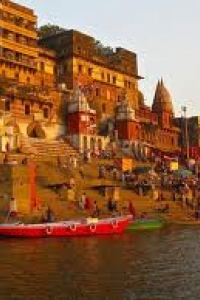
Brace yourself. You're about to enter one of the most blindingly colourful, unrelentingly chaotic and unapologetically indiscreet places on earth.
Varanasi is a melting pot, where both death and life come together. Every devout Hindu hopes to visit the city at least once in a lifetime, take a holy dip at the famous 'Ghats' of the Ganga, walk the pious Panchakosi road that bounds the city, and, if God wills, die here in old age. The former name of the city, 'Kashi' signifies that it is a 'site of spiritual luminance.' Indeed it is! Not only is Varanasi a place for pilgrimage, it is also a great center of learning, and a place known for its heritage in music, literature, art and craft. It is a cherished name in the art of silk weaving.
The Banarasi silk sarees and brocades are prized all over the world. The classical musical styles or 'gharanas' are woven into the lifestyle of the people and are accompanied by musical instruments that are manufactured in Varanasi. Many religious texts and theosophical treatises have been written here. It is also the seat of one of India's biggest universities, the “Banaras Hindu University”. To the Hindus, the Ganges is a sacred river and any town or city on its bank is believed to be auspicious. But Varanasi has a special sanctity, for it is believed, this is where Lord Shiva and his consort Parvati stood when time started ticking for the first time. The place also has an intimate connection with a host of legendary figures and mythical characters, who are said to have actually lived here. Varanasi has found place in the Buddhist scriptures as well.
With the sun rise the Ghats burst into activity. In the morning, the Ghats present a charged holistic atmosphere. Brahmins recite passages from sacred texts and priests perform various kinds of holy rituals. Perhaps Varanasi is the only place that stirs an individual to reflect about life, to contemplate about creation and the irrelevance of temporal wealth in the face of death. The burning Ghats at the edge of River Ganga keep reminding people that life is mortal. At the same time, the rising sun and the morning and evening rituals at the Ghats bring hope and optimism to thousands of beleaguered people. This is the essence of Varanasi- "the Gateway to Moksha."
Legends have it that the holy city of Varanasi was founded centuries before the birth of the Christ. Varanasi is situated between the two tributaries of River Ganga- Varuna to the north and Asi to the south. Varanasi combines the name of both these rivers. Varanasi is mentioned in Holy Scriptures like Puranas, Buddhist texts and in the Mahabharata. The most fascinating part of the holy city of Varanasi is that almost all the activities seem to revolve around river Ganga and its Ghats. Life on the banks of the Ganga begins before dawn, when thousands of pilgrims come to the river for the holy dip. It is believed that the sacred river will cleanse them of their sufferings and wash their sins away.
Varanasi is the oldest and the most sacred place for the Hindus. Varanasi, also known as the holy city, combines in itself the cultural essence and mysticism of India. Varanasi stands on the banks of river Ganga, considered the holiest of all Indian rivers. Varanasi or Kashi is both an exalted place of pilgrimage and a microcosmic centre of faith. A large number of pilgrims visit the holy city from all parts of India and the world.
Varanasi is a unique city where the past and present, eternity and continuity live side by side.
About the Author






Comments